How Speech Therapy Assists in Treating Dysphagia and Swallowing Issues
Revolutionizing Swallowing Care with Speech Therapy

Understanding the Role of Speech Therapy in Dysphagia Management
Dysphagia, or difficulty swallowing, is a complex condition resulting from various neurological, structural, and muscular factors. Effective management is essential to prevent serious health complications and improve quality of life. Speech therapy, provided by trained speech-language pathologists (SLPs), plays a pivotal role in diagnosing, treating, and educating patients about swallowing disorders. This article explores how speech therapy aids in the treatment of dysphagia, encompassing assessment techniques, therapeutic approaches, and evidence-based practices.
Assessment and Diagnosis of Dysphagia by Speech-Language Pathologists
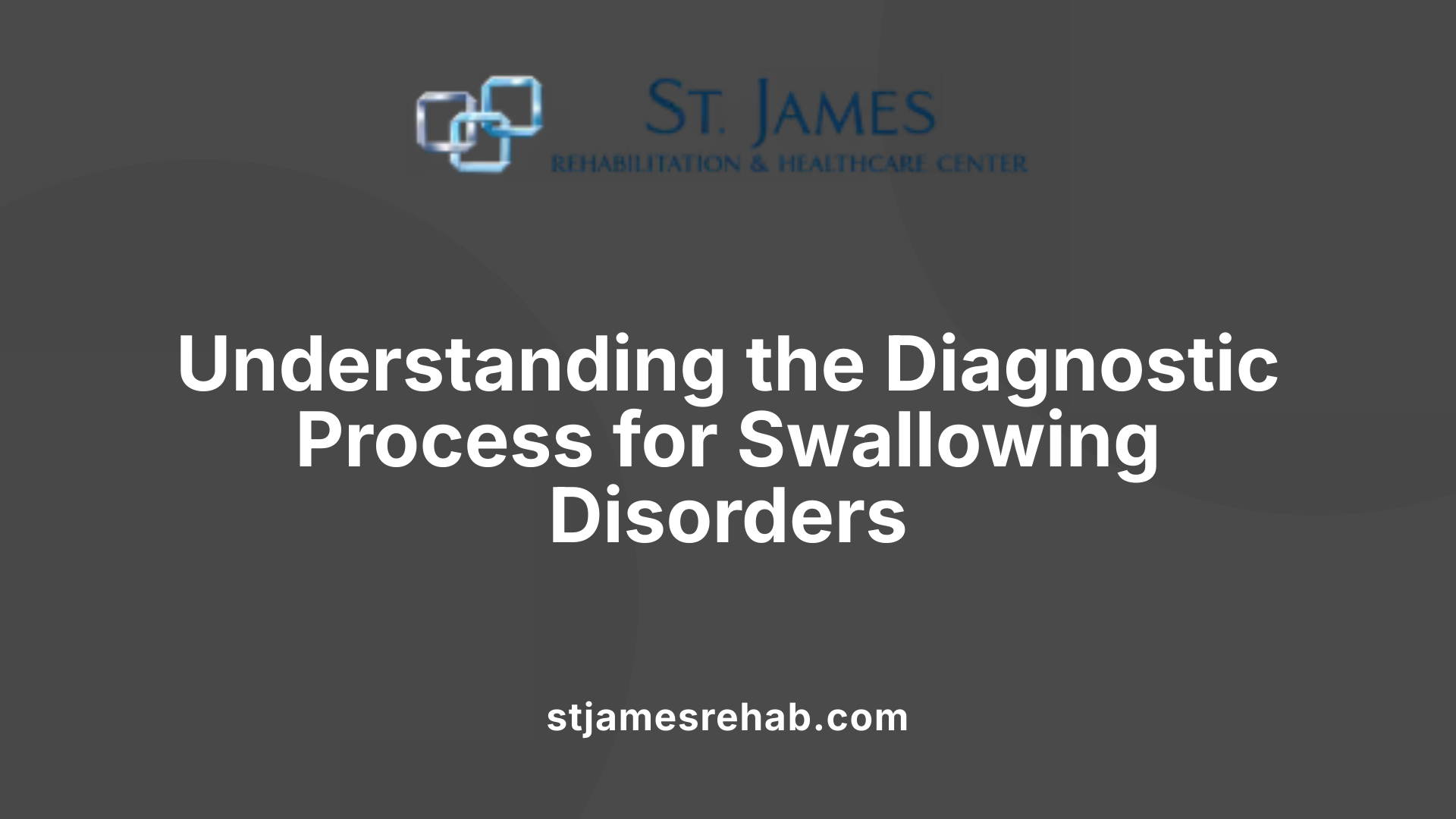
How are swallowing disorders assessed and diagnosed by speech therapists?
Speech therapists play a crucial role in identifying and diagnosing dysphagia, the swallowing disorder. They begin with a thorough review of the patient’s medical history, including any neurological conditions like stroke, Parkinson’s disease, or head injury. This background helps identify potential causes and approaches for assessment.
The initial clinical evaluation typically involves observing the patient during a bedside swallow test. During this assessment, the therapist watches for signs such as coughing, choking, drooling, or wet voice quality, as these indicate swallowing difficulties. The therapist may also ask the patient to perform specific tasks, like dry swallowing or swallowing different food textures, according to established standards, such as the International Dysphagia Diet Standardisation Initiative (IDDSI) guidelines.
In addition to physical observations, instrumental evaluations provide detailed insights into swallowing physiology. The most common assessments include:
| Evaluation Type | Description | Purpose |
|---|---|---|
| Videofluoroscopic Swallow Study (VFSS) | A moving X-ray using barium to visualize the swallowing process | To identify structural or functional abnormalities and determine safe food and liquid consistencies |
| Fiberoptic Endoscopic Evaluation of Swallowing (FEES) | Insertion of a flexible scope through the nasal passage to view the throat during swallowing | To assess pharyngeal and laryngeal function and detect silent aspiration |
These tests are essential for pinpointing impairments that are not visible during clinical observation. The evaluation process also considers symptoms like recurrent pneumonia, weight loss, or food sticking in the throat.
Therapists often incorporate reflux evaluation tools like the Reflux Symptom Index to investigate gastroesophageal causes or contributing factors. Based on the comprehensive assessment, the speech-language pathologist develops personalized treatment strategies aimed at improving swallowing safety and efficiency.
Regular reassessment ensures that interventions remain effective and tailored to the patient’s evolving needs. When necessary, the team collaborates with medical professionals to optimize overall care. This thorough diagnostic approach ensures that each individual receives targeted and effective management of their swallowing disorder.
How Speech Therapy Helps in Treating Dysphagia and Swallowing Issues
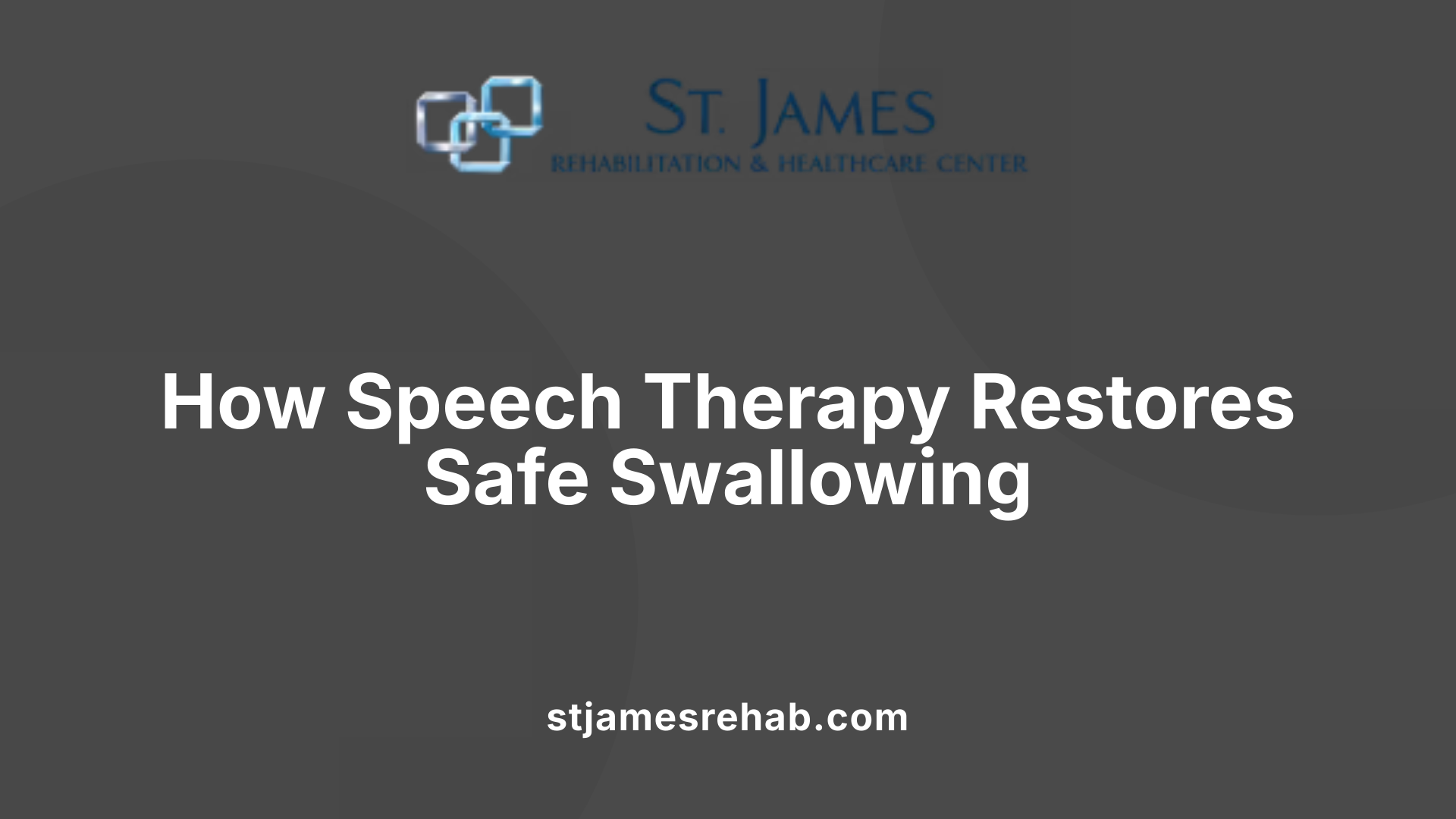
How does speech therapy help in treating dysphagia and swallowing issues?
Speech therapy is an essential approach in managing dysphagia, a disorder that impacts the ability to swallow safely and efficiently. Speech-language pathologists (SLPs) utilize a combination of techniques tailored to each patient's specific needs. One important aspect involves compensatory strategies, such as adjusting head and neck positioning—like the chin tuck maneuver—to protect the airway and reduce the risk of choking.
They also suggest modifications in food and liquid textures, for example, using pureed or softer foods, to make swallowing safer. These strategies help manage symptoms during meals while supporting adequate nutrition and hydration.
Alongside these, targeted exercises are prescribed to strengthen the muscles involved in swallowing. These include activities like dry swallowing, straw exercises, and other muscle training routines designed to enhance muscle strength, coordination, and control.
For example, straw exercises improve the coordination needed for controlled liquid swallowing, whereas dry swallowing helps build muscle endurance and motor planning.
Therapists assess the specific stage of swallowing affected—oral, pharyngeal, or esophageal—and develop personalized plans to address these challenges. This may involve neuromuscular exercises or the use of biofeedback devices to monitor muscle activity and optimize therapy outcomes.
The ultimate goal of speech therapy is to improve safety and effectiveness during swallowing, reduce the risk of aspiration pneumonia, and enhance overall quality of life. Regular therapy sessions and comprehensive evaluations ensure progress, helping individuals regain confidence in eating and drinking, and enabling them to resume a more normal diet under medical supervision.
Therapeutic Approaches and Techniques in Speech Therapy for Swallowing Problems
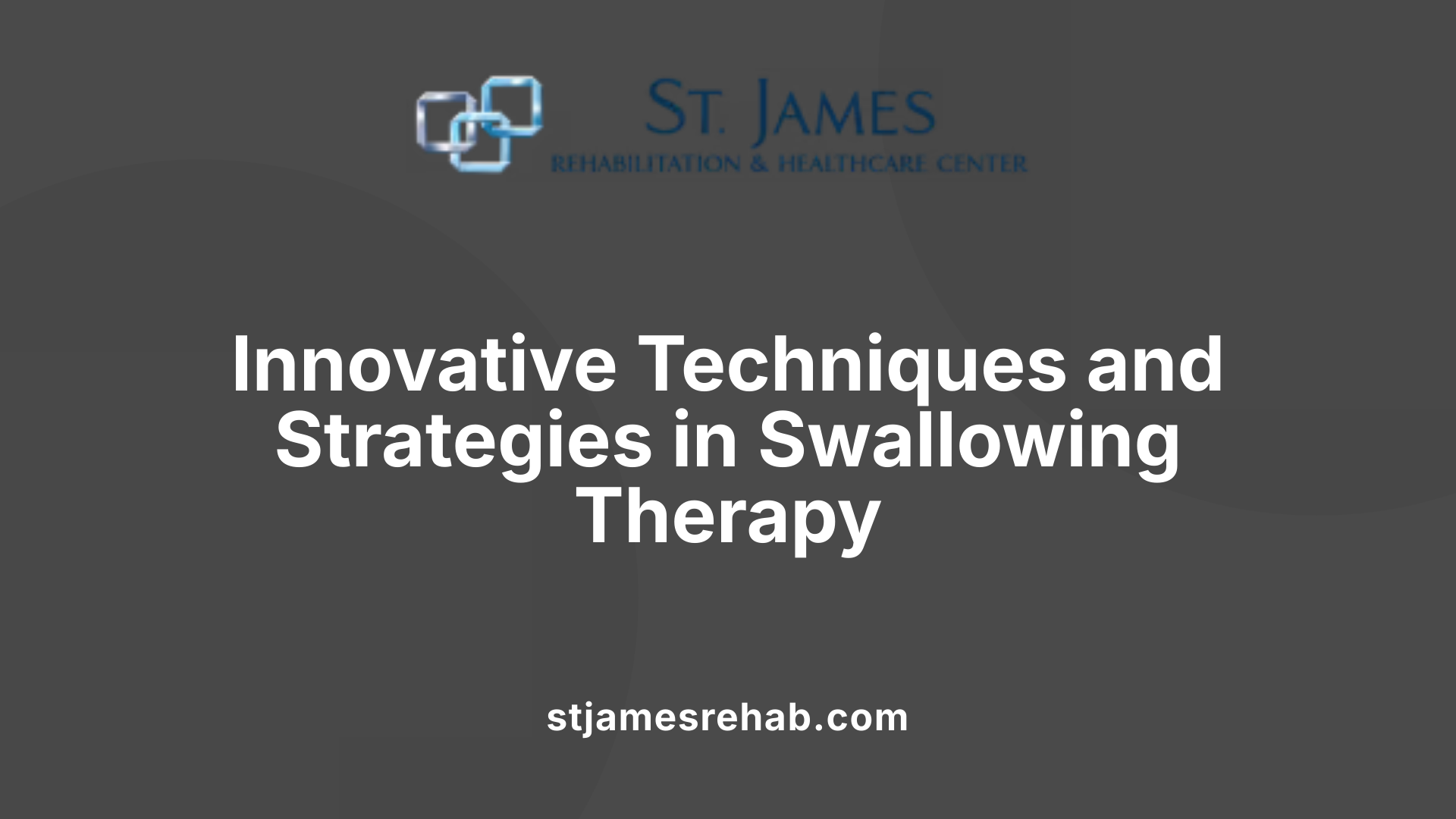
What therapeutic approaches and techniques are used in speech therapy for swallowing problems?
In speech therapy, managing swallowing disorders—or dysphagia—entails a combination of techniques designed to improve safety, strength, and coordination of the muscles involved. Speech-language pathologists (SLPs) utilize a range of personalized strategies based on the individual’s specific needs and the affected stage of swallowing.
One core component involves tailored exercises and maneuvers that directly target the muscles used in swallowing. For example, exercises like dry swallowing help strengthen the muscles and control, while maneuvers such as the chin tuck or head turn are used to position the head and neck to prevent aspiration and facilitate safer swallowing.
SLPs also employ advanced tools such as biofeedback devices and neuromuscular electrical stimulation to provide real-time feedback during exercises, helping patients learn optimal muscle movement and improve their swallowing function effectively.
Diet modifications are another vital aspect of therapy. Adjusting the viscosity of liquids—using thickening agents—and modifying the texture of foods (e.g., pureed or soft foods) help reduce the risk of choking or aspiration. These modifications are carefully prescribed based on thorough assessments.
Posture and head positioning strategies, such as the chin tuck, are simple yet effective techniques used during eating or swallowing to promote safer swallowing mechanics. These adjustments help protect the airway by directing food away from the lungs.
Specific exercises like the Masako maneuver involve swallowing while holding the tongue between the teeth, which helps strengthen the posterior pharyngeal wall muscles. Such targeted activities are selected according to the particular stage of swallowing that is impaired.
By combining these approaches—techniques, exercises, nutritional modifications, and positioning strategies—SLPs aim to enhance swallowing safety, restore function where possible, and improve the patient's overall quality of life. Instrumental evaluations, such as videofluoroscopic swallow studies, play an essential role in visualizing swallowing and tailoring each treatment plan for maximum effectiveness.
The Process of Speech Therapy in Managing Swallowing Disorders
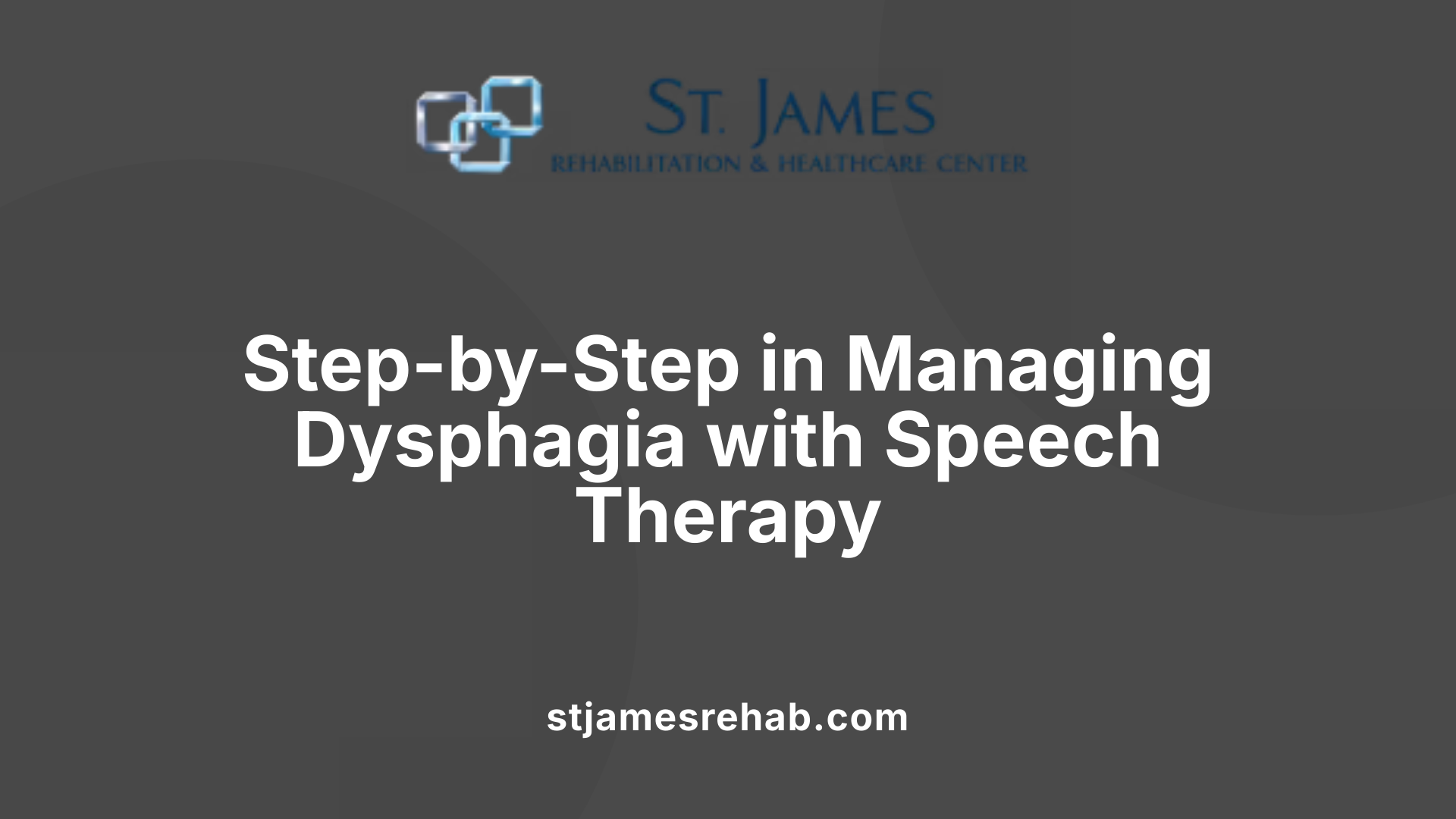
What is the process involved in speech therapy for swallowing disorders?
The journey of managing swallowing issues through speech therapy begins with an extensive assessment conducted by a certified Speech-Language Pathologist (SLP). This initial phase often includes reviewing the patient's medical history, conducting a clinical examination of the oral and cranial nerves, and performing a bedside swallow evaluation.
To gain detailed insight into the swallowing mechanics, instrumental assessments such as the Modified Barium Swallow Study (VFSS) or the Fiberoptic Endoscopic Evaluation of Swallowing (FEES) are frequently utilized. These procedures visually capture how food and liquids move through the mouth and throat, helping to identify any abnormalities like silent aspiration—where food enters the airway without apparent choking.
Following the assessment, the SLP creates a tailored treatment plan targeting the patient’s specific needs. This plan combines compensatory strategies—including proper head positioning like the chin tuck and modifications in food textures—with direct exercises aimed at strengthening the muscles involved in swallowing.
Therapeutic activities may include exercises like dry swallowing, straw drinking practices, or maneuvers designed to improve coordination and muscle function. The goal is not only to reduce the risk of aspiration but also to enhance overall swallowing efficiency and safety.
Throughout the course of therapy, the SLP continuously monitors progress through regular reassessments. Adjustments are made to exercises, strategies, and dietary recommendations to optimize results. Patient and caregiver education is also a vital component, ensuring that techniques learned in therapy can be safely implemented at home.
This comprehensive approach ultimately aims to restore the ability to swallow safely and enjoy a better quality of life, especially for those with neurological or structural impairments affecting their swallowing function.
Benefits and Effectiveness of Speech Therapy in Treating Dysphagia
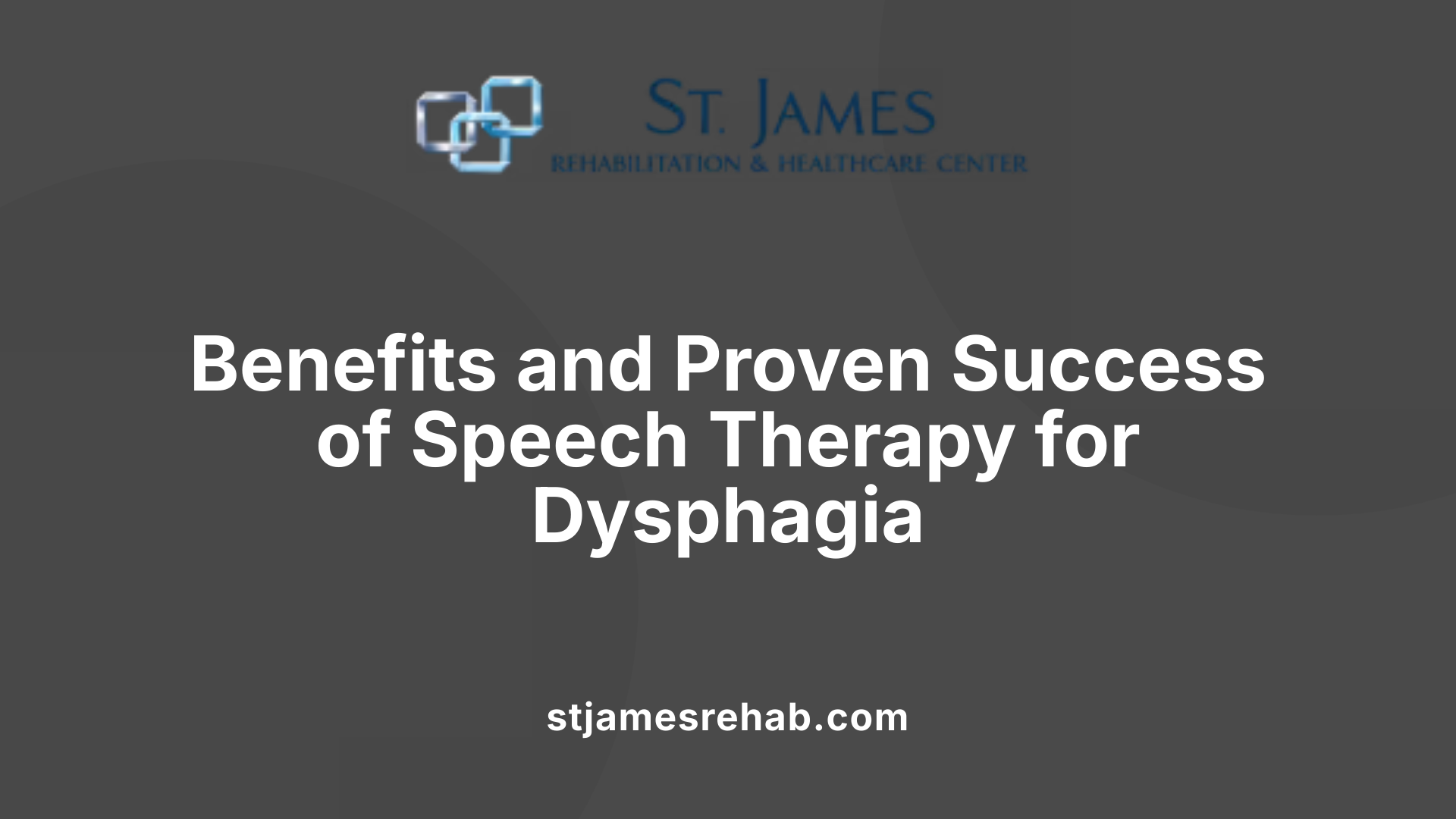
What are the benefits and effectiveness of speech therapy in treating dysphagia?
Speech therapy offers numerous advantages for individuals suffering from swallowing disorders, known as dysphagia. One of the primary benefits is improving swallowing safety, which helps prevent food or liquids from entering the airway—a condition called aspiration. Aspiration can lead to serious complications like pneumonia, a common and potentially life-threatening infection in dysphagia patients.
Through a combination of tailored techniques, speech-language pathologists (SLPs) use strategies such as proper head positioning, including the chin tuck maneuver, and modifications of food and liquid textures—like thickening liquids or pureeing foods—to support safer swallowing. These compensatory approaches are complemented by direct exercises aimed at strengthening the muscles involved in swallowing.
These exercises include various muscle training routines, such as dry swallowing techniques and straw exercises, which enhance muscle strength and coordination. Strengthening these muscles not only improves the ability to swallow but also reduces the effort and discomfort associated with the process.
The effectiveness of speech therapy is supported by clinical research. Numerous studies, including randomized controlled trials, have demonstrated significant improvements in swallowing function after targeted therapy. Instrumental assessments, such as the Modified Barium Swallow Study, allow clinicians to identify which phases of swallowing are affected and to tailor treatments accordingly.
Overall, speech therapy can help patients regain safe and efficient swallowing, substantially reducing health risks like malnutrition, dehydration, and pneumonia. It can also improve the person's quality of life by enabling a return to more normal diets and social eating activities.
Research continues to expand understanding of these therapies, affirming their vital role in managing dysphagia and supporting patient recovery.
Research and Evidence Supporting Speech Therapy Interventions for Dysphagia
What research and evidence support speech therapy interventions for dysphagia?
Numerous studies and systematic reviews back the use of speech therapy for managing dysphagia, demonstrating their safety and effectiveness. The American Speech-Language-Hearing Association (ASHA) maintains an Dysphagia Evidence Map that consolidates current research findings.
Research includes a mix of clinical trials, randomized controlled trials (RCTs), and high-quality non-randomized studies. Many trials have explored various interventions, such as neuromuscular electrical stimulation (NMES), swallowing exercises, and sensory stimulation techniques. These studies assess outcomes like swallowing safety, muscle strength, and patient quality of life.
Interventions like NMES have shown promise in improving swallowing function, especially when combined with exercise therapy. Rehabilitative exercises—such as effortful swallow, Mendelsohn maneuver, and other maneuvers—are supported by evidence indicating improvements in muscle coordination and strength.
However, despite positive findings, many studies face methodological limitations such as small sample sizes, lack of control groups, and inconsistent protocols. Therefore, while the overall evidence supports the effectiveness of speech therapy techniques, further rigorous research is necessary to confirm long-term benefits and optimal treatment protocols.
Evidence-based practice in dysphagia emphasizes individualized assessments using instrumental tools like videofluoroscopy (VFSS) and fiberoptic endoscopic evaluation of swallowing (FEES). These tools help tailor therapy plans and confirm the effects of specific interventions.
Guidelines recommend combining compensatory strategies—such as posture adjustments—with rehabilitative exercises and diet modifications, based on the patient's specific needs and condition severity. Therapy outcomes are regularly monitored to adapt treatment plans, maximizing safety and functional improvement.
In summary, current research underscores the vital role of speech-language pathologists in delivering effective treatments for dysphagia, supported by a growing body of evidence, but highlights the need for more high-quality clinical trials to establish stronger, universally accepted protocols.
Empowering Patients and Enhancing Outcomes
In summary, speech therapy is a cornerstone in the effective management of dysphagia and swallowing issues. Through comprehensive assessment, personalized intervention plans, and evidence-based techniques, speech-language pathologists significantly improve patients’ safety, nutritional status, and overall quality of life. Ongoing research continues to refine therapeutic methods and expand understanding of optimal practices, emphasizing the importance of multidisciplinary collaboration. Educating patients and caregivers about swallowing techniques and available therapies fosters informed decision-making and adherence to treatment plans. As advancements emerge, speech therapy remains an indispensable component of modern dysphagia care, offering hope and tangible benefits to countless individuals worldwide.
References
- How Does Speech Therapy Help With Swallowing Problems?
- Dysphagia Speech Therapy: How It Helps with Speech?
- Adult Dysphagia - ASHA
- Speech Therapy for Swallowing Disorder Patients
- Effects of Therapy in Oropharyngeal Dysphagia by Speech and ...
- Dysphagia and Swallowing Therapy
- How could a speech and language therapist help with swallowing ...
- Swallow This: Treat Dysphagia with Speech Pathology
- The Historical role of the SLP in dysphagia management
- How Speech Therapy Helps with Dysphagia?






